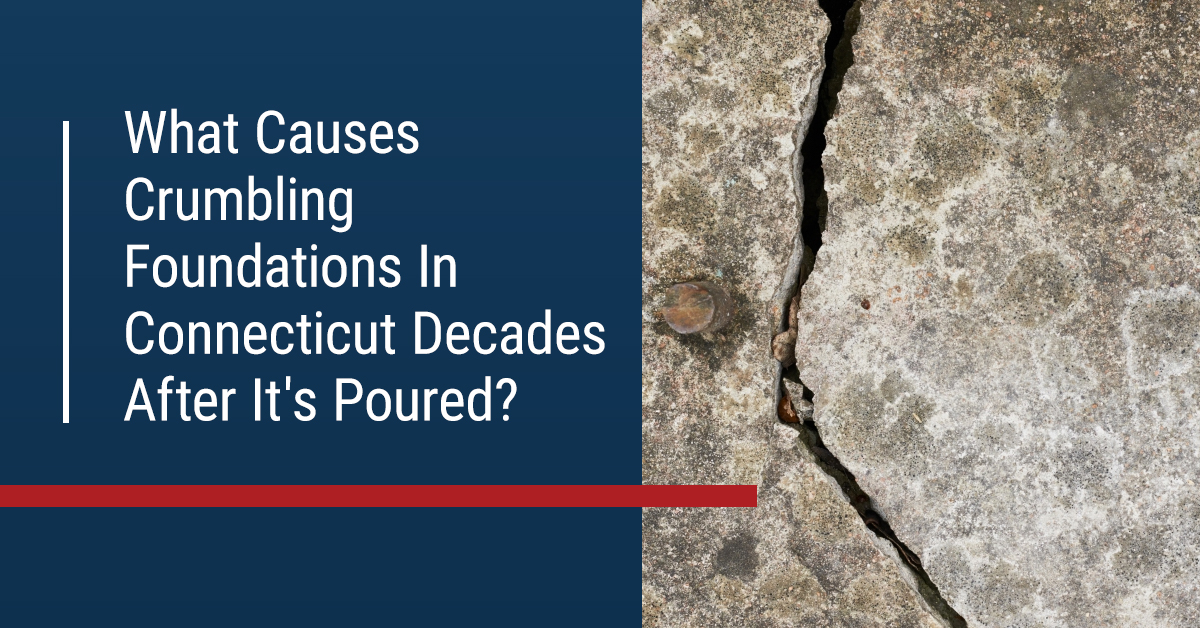
What Causes Crumbling Foundations In Connecticut Decades After It’s Poured?
In our most recent blog, we discussed the things that can go wrong with concrete foundations when the concrete is poured. Improper mixing by the concrete contractor is one of the most common reasons for crumbling foundations in Connecticut and throughout the Northeast. Weather also plays a big part in how well concrete cures: rain can add too much water to the mixture wind can remove too much via evaporation, and the temperature can drastically change how long it takes for concrete to cure. Someone pouring concrete needs to know what they’re doing so that they can take all of these into account.
But those variables all occur when concrete is poured. Even if the concrete is mixed and poured properly, what affects concrete in the long-term, decades after it has cured? That’s what we’re here to talk about today, because foundation crumbing in Connecticut is actually worse than in most places. What homes might require house lifting and foundation replacement? Let’s find out.
Pyrrhotite
If you’ve heard about the crumbling foundation problem affecting northeast Connecticut, you’ve heard about pyrrhotite. Pyrrhotite is an iron sulfide mineral that occurs naturally in certain places, and as it reacts with oxygen and water (as all foundations do), it expands and causes the foundation to crack and deteriorate. Unfortunately, these cracks aren’t just surface problems; they crumble and threaten the integrity of the entire house.
The pyrrhotite problem could affect as many as 35,000 homes in the northern part of Connecticut. So far, more than 41 towns have reported crumbing foundation problems due to pyrrhotite. The towns most commonly affected have been Stafford, Tolland, Willington, Vernon, Manchester, South Windsor, Enfield, Ellington, Ashford, and Coventry, but over 30 more areas have reported problems. All of these homes were built post-1980.
How did this problem originate? The rocks used as aggregate to build the foundations of these homes also included pyrrhotite. While most quarries don’t contain pyrrhotite, the one in Willington was one of the rare ones that did.
What can be done? The concrete in its current state is not able to be fixed, and the problem will just keep getting worse until the integrity of the house is threatened. The only real way to fix the problem is to perform house lifting, remove the old crumbling foundation, and pour a new one. This can cost $175,000 or more, and a plan was recently enacted to help homeowners who were unfortunate enough to purchase a house with the problem. There is even funding offered by some towns that will help pay for the tests needed to verify the presence of pyrrhotite. Click here to learn more about it and how who you can contact to seek help.
Erosion, Sinkholes, and Improper Compacting
Concrete is incredibly strong, and in the right place, it can support buildings for thousands of years. Unfortunately, the ground on which the concrete is placed can play a big part in how well it holds up.
If you were to place a concrete slab on a solid steel surface, it might never crack because it’s being supported equally and evenly. But that exact same slab of concrete could easily crack if the ground under it isn’t providing equal support. Underground water sources can create sinkholes and take away the support that a concrete foundation once had. Water that gets under the slab can also wash away the dirt over many years, until eventually there’s not enough soil to hold the weight.
Of course, there’s also the problem of soil that wasn’t properly compacted before the foundation was poured. When a new neighborhood is built, many builders will rush the process of compacting the ground in order to save time and gasoline. As the foundation itself places weight on the soil over the years, it compacts and places uneven stress on the concrete.
Water Expansion
Once concrete foundations start to crumble, the problem often gets worse exponentially faster. That’s because cracks allow water in, and when water expands it forces the concrete apart. While it might not seem possible for ice to destroy concrete, it’s a common occurrence. The freeze-thaw cycle can happen hundreds of times during the winter months, chipping away at the concrete and allowing more water in. Over time, expanding water can destroy any foundation once it finds a crack.
What Can Be Done With A Crumbling Foundation?
As we mentioned, homes foundations that are affected by pyrrhotite need to have the home lifted and the entire foundation replaced. Failing to do so could cause catastrophic loss of the home and make it worthless. But foundations that were built on weak soil might be able to be repaired, which is a considerably cheaper option!
If you have a crumbling foundation, we hope you’ll contact Payne Constructions Services so that you can get your life back in order. Start the conversation right here!

